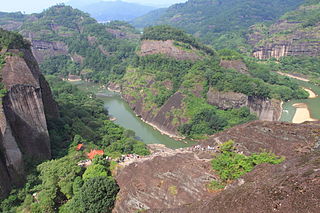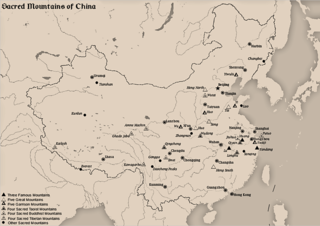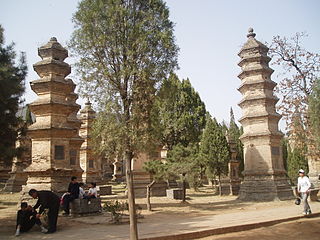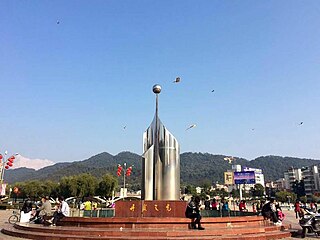| Mount Jianglang | |
|---|---|
| Jiāngláng Shān | |
| Highest point | |
| Elevation | 816.8 m (2,680 ft) [1] |
| Listing | List of mountains of China |
| Coordinates | 28°31′47″N118°33′55″E / 28.52972°N 118.56528°E Coordinates: 28°31′47″N118°33′55″E / 28.52972°N 118.56528°E |
| Geography | |
| Location | Zhejiang, China |
Jianglangshan or Mount Jianglang (Chinese :江郎山; pinyin :Jiāngláng Shān) is a mountain in Jiangshan, Zhejiang, China. Three peaks from north to south make its recognizable "river-shaped" arrangement, as follows: Lang Feng, Ya Feng and Ling Feng. Lang Feng has elevation of 816.8 m (2,680 ft). [1]

Chinese is a group of related, but in many cases not mutually intelligible, language varieties, forming the Sinitic branch of the Sino-Tibetan language family. Chinese is spoken by the ethnic Chinese majority and many minority ethnic groups in China. About 1.2 billion people speak some form of Chinese as their first language.
Hanyu Pinyin, often abbreviated to pinyin, is the official romanization system for Standard Chinese in mainland China and to some extent in Taiwan. It is often used to teach Standard Mandarin Chinese, which is normally written using Chinese characters. The system includes four diacritics denoting tones. Pinyin without tone marks is used to spell Chinese names and words in languages written with the Latin alphabet, and also in certain computer input methods to enter Chinese characters.

A mountain is a large landform that rises above the surrounding land in a limited area, usually in the form of a peak. A mountain is generally steeper than a hill. Mountains are formed through tectonic forces or volcanism. These forces can locally raise the surface of the earth. Mountains erode slowly through the action of rivers, weather conditions, and glaciers. A few mountains are isolated summits, but most occur in huge mountain ranges.
The mountain exhibits Danxia landform, and was inscribed onto the World Heritage List in August 2010 as part of China Danxia. [2]

The Danxia landform refers to various landscapes found in southeast, southwest and northwest China that "consist of a red bed characterized by steep cliffs". It is a unique type of petrographic geomorphology found in China. Danxia landform is formed from red-coloured sandstones and conglomerates of largely Cretaceous age. The landforms look very much like karst topography that forms in areas underlain by limestones, but since the rocks that form danxia are sandstones and conglomerates, they have been called "pseudo-karst" landforms. They were formed by endogenous forces and exogenous forces.
In September 2013, Mount Jianglang was the scene for a stunt by Jeb Corliss where he flew between two of the peaks in a wing suit, starting the jump from a helicopter. [3]

A stunt is an unusual and difficult physical feat or an act requiring a special skill, performed for artistic purposes usually on television, theatre, or cinema. Stunts are a feature of many action films. Before computer generated imagery special effects, these effects were limited to the use of models, false perspective and other in-camera effects, unless the creator could find someone willing to jump from car to car or hang from the edge of a skyscraper: the stunt performer or stunt double.
Jeb Corliss is an American professional skydiver and BASE jumper. He has jumped from sites including Paris' Eiffel Tower, Seattle's Space Needle, the Christ the Redeemer statue in Rio de Janeiro and the Petronas Twin Towers in Kuala Lumpur, Malaysia. He lives in Venice, California.
















